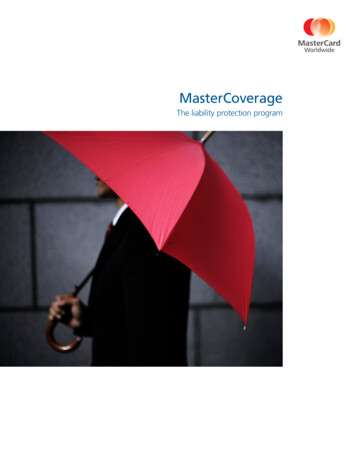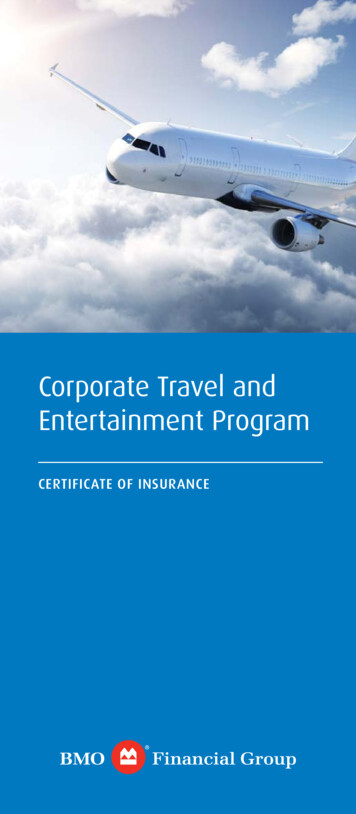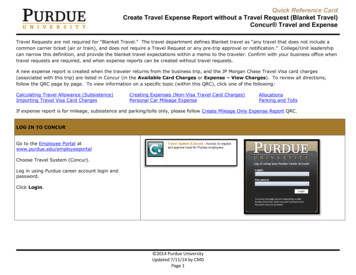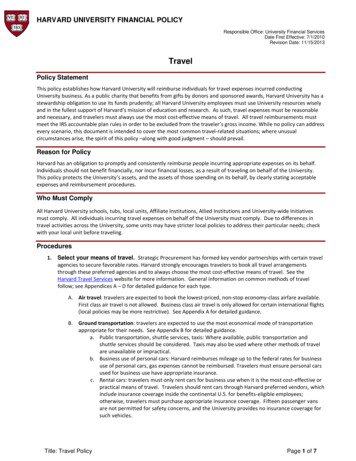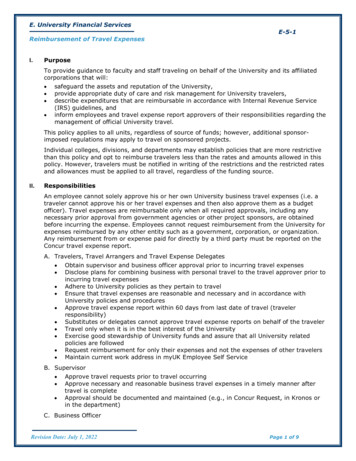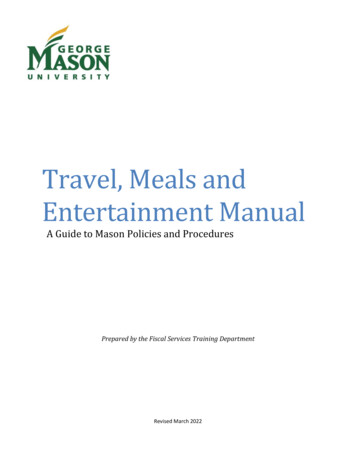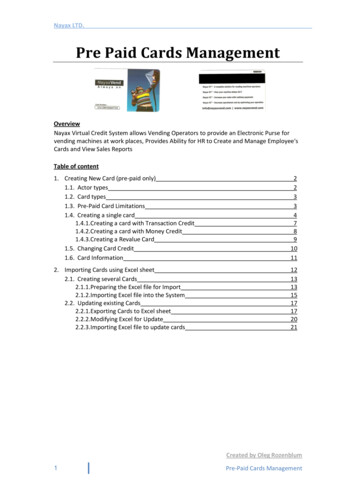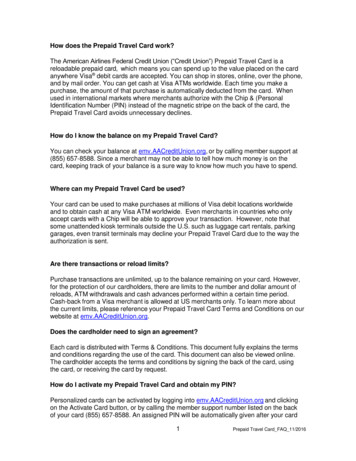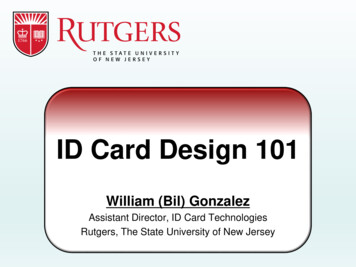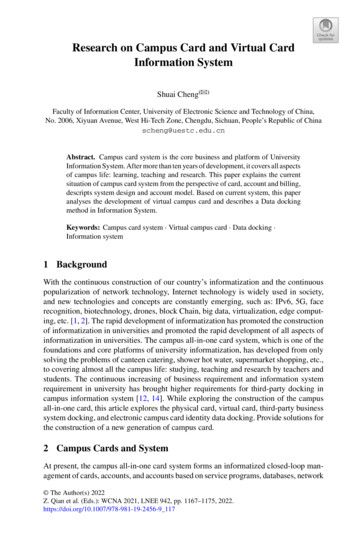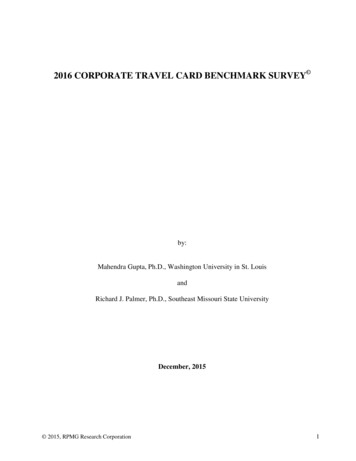
Transcription
2016 CORPORATE TRAVEL CARD BENCHMARK SURVEY by:Mahendra Gupta, Ph.D., Washington University in St. LouisandRichard J. Palmer, Ph.D., Southeast Missouri State UniversityDecember, 2015 2015, RPMG Research Corporation1
2016 CORPORATE TRAVEL CARD BENCHMARK SURVEY TABLE OF CONTENTSSection #Section TitlePage #Introduction.31Confidentiality Agreement and Consent to Use .42Respondent Data .53Organizational Description and Travel Card Program Goals .74Current Travel Card Spending .105Past and Future Travel Card Spending .156Travel Policy and Booking Practice .197Travel Expense Management System.218Mobile Technology and Travel .249Travel Card Controls and Compliance .2610Expense Report Processing and Performance Measurement .2911Leveraging Travel Card Data.3212Global Card Use .3513Program Configuration and Features .3714Card Issuer Switching Behavior .3815Travel Card Misuse .3916Satisfaction with the Card Issuer .42About the Authors.48 2015, RPMG Research Corporation2
IntroductionWelcome to the 2016 Corporate Travel Card Benchmark Survey. The survey is designed to enhance yourunderstanding of the critical factors that contribute to corporate travel card program success. Thirteen majorNorth American financial institutions and members of the National Institute of Governmental Purchasing and theNational Association of Purchasing Card Professionals are supporting and participating in the survey project.There is no charge for participation. A strict confidentiality agreement is enforced and included on the nextpage.BENEFITS OF PARTICIPATIONIn recognition of your contribution of time and effort, all organizations completing this survey will receive anelectronic copy of the 2016 Corporate Travel Card Benchmark Survey Report (a 1,099 value) free of charge.The Report will include comprehensive information and expert analyses that will enable your organization to: Benchmark its corporate travel card program statistics, controls, card uses, and future trends against those oftop card programs by company size, industry, or type of governmental agency; Identify key driver to unlock potential travel card benefits; Obtain best practice information to improve corporate travel card program performance and enhancesatisfaction with its travel card product; Get information on emerging trends in travel card and travel card-related practice, including the use ofmobile technologies, virtual cards for travel, booking practices, and expense management systems, and Provide card issuers insights into how to better serve your needs.To further encourage participation, the first 100 respondents who complete the survey will receive a 50Amazon.com gift certificate and the next 500 respondents who complete the survey will receive a 25Amazon.com gift certificate. Further, every participant who completes the survey will immediately be ableto download an electronic copy of the “2013 Corporate Travel Card Benchmark Survey Report,” an 899value. This report, a “must have” for the research library of any organization with a travel card program, willenable the reader to immediately get a rich set of information and benchmark results from the 2013 survey.Collectively, all respondents will receive more than 1,950 in incentives for completing the survey.IMPORTANT SURVEY INSTRUCTIONSThis survey is an in-depth examination of how organizations use travel cards and was developed with extensiveinput from travel card users and issuers. Participants will derive the greatest benefit if all questions areanswered. Most questions can be answered by the travel card program administrator with simple checkmarksor by providing well-known program statistics. With the exception of required questions, if any question doesnot apply to your organization or if the answer is unavailable for any reason, simply leave the item blank.Completion of the survey should take approximately 45-80 minutes, depending on information availability.If you have any questions about the survey, contact Professor Richard Palmer by e-mail(richard.palmer@RPMGresearch.net) or phone (618.559.5137).Please send the completed survey to:RPMG Research Corporation1616 West Main Street, Suite 502Marion, IL 62959 2015, RPMG Research Corporation3
SECTION 1: Confidentiality Agreement and Consent to UseRPMG Research Corporation maintains a policy of strict confidentiality with respect to your responses tothis survey. RPMG Research Corporation, its employees and agents, shall keep all individual responses tothe “2016 Corporate Travel Card Benchmark Survey” confidential and shall not disclose the responses to anyperson or other entity. In addition, all information, analysis, responses, and other data that is specific to oridentifies a specific card issuer shall be kept confidential and shall be released only to that specific cardissuer. This confidentiality agreement will apply to any person in the employment of or assisting RPMGResearch Corporation in the analysis of survey data or compilation of survey results. Notwithstanding thefact that individual responses are and shall remain confidential, the aggregated responses of surveyparticipants shall be made public in benchmark results, professional presentations, and published andunpublished documents authored by RPMG Research Corporation personnel bound by this agreement.By providing responses to this survey, you agree to allow RPMG Research Corporation to combine yourresponse with others to create survey reports, presentations, and other analyses that describe best use and valuedelivered by travel cards in the North American market. (Required) Agree Do Not AgreeNote: Without consent, you may not participate in the survey. If you would like to obtain more informationabout the survey or the benchmark report, please contact Richard Palmer by e-mail(richard.palmer@RPMGresearch.net) or phone (618.559.5137).Please note:The 2016 Corporate Travel Card Benchmark Survey, including questions and other content herein, is the copyrightedwork of Richard Palmer and Mahendra Gupta. Any use or duplication of the questions or content of this survey withoutthe express written consent of the authors will be a violation of United States copyright law. 2015, RPMG Research Corporation4
SECTION 2: Respondent Data1(a). Information about the person responsible for completion of the survey.Name:Title:Phone number: ( ) - Extension:1(b). Your e-mail address at your organization* (Required):* In order to receive the free PDF copy of the 2016 Corporate Travel Card Benchmark SurveyResults, you must include your e-mail address at your organization. Further, any gift certificatethat may apply for early response will only be sent to your organization e-mail address.1(c). In the event that we need to clarify your responses to the survey,may we contact you? Yes No1(d). Would you like to be notified about future commercial card surveysor reports? Yes No2(a). Information about the organization using corporate travel cards:Organization name:Street address:City:State or province:Country:Postal code:2(b). What is the name of the bank or financial institution that provides your organization with most or all of itscorporate travel cards and travel card accounts? American Express Bank of America BBVA Compass BMO/Harris Bank Capital One Citibank Comdata Commerce Bank 2015, RPMG Research Corporation Diner’s Club Electronic Funds Source (EFS) HSBC JPMorgan Chase PNC Bank Regions Bank Scotiabank SunTrust Bank TD Bank UMB US Bank US Bank Canada Wells Fargo Bank WEX Zions Bank Other (please name):5
2(c).Identify the brand associated with the travel card used by your organization: American Express Diner’s Club MasterCard Visa Other (please identify):2(d).You are responding to this survey based on an invitation from: (check all that apply) Your travel card issuer National Association of Purchasing Card Professionals (NAPCP) The Accounts Payable and Procure-to-Pay Network (AP & P2P) National Institute of Governmental Purchasing (NIGP) RPMG Research Corporation Other (please describe):2(e).How would you categorize your travel card program? “Traditional program” in which travel card accounts are used primarily or exclusively (75% to100%) for travel-related expenses Travel card accounts are used for all types of purchases, but at least half of card spending (50%to 74%) is for travel-related expenses Travel card program where less than half of card spending (1% to 49%) is for travel-relatedexpenses Other (please describe): 2015, RPMG Research Corporation6
SECTION 3: Organizational Description and Travel Card Program Goals3.Organization description (please check one) (Required): Public corporation Privately-owned corporation Public college or university Private college or university School district State/province or state/provincial government agency City/county or city/county government agency Federal government agency Not-for-profit organization Other (please describe):If you chose “public corporation,” “privately-owned corporation,” or “other,” please answerQuestions 3(a) and 3(b); otherwise skip to Question 4.3(a).Please check the best description of your company’s geographic footprint. A North American company (U.S. or Canada) with all operations and sales in North America A North American company (U.S. or Canada) with all operations in North America, butsignificant sales to customers outside of North America A multinational company with significant operations and sales in multiple continents around theglobe Other (please describe):3(b).Please check the industry classification/activities of your company (please check all that apply): Administrative and support services Advertising and marketing Agriculture, forestry, and fishing Arts and entertainment Automotive retailing and service Construction Consulting Educational services Finance, insurance, and banking Food service and restaurants Hospitals Hotels Life sciences Management of facilities and companies Manufacturing Mining, oil and gas extraction, pipeline, Pharmaceuticals Publishing and media (including broadcasting andrecording) Professional, scientific, and technical services Real estate Rentals and leasing Social services Software and information technology Telecommunications and data processing services Transportation Tourism and leisure Utilities (gas, electrical, and water) Warehousing and distribution services Wholesale and retail trade Other (please describe):and refining services 2015, RPMG Research Corporation7
4.Please provide a brief description of your organization’s business activities or primary product/service:5.Employees of your organization that are given corporate travel cards are: primarily or exclusively based in the U.S. and Canada based in and outside of the U.S. and Canada6.How long has your corporate travel card program been in place? Less than one year 1-3 years7. 12-16 years 17-20 years 21 yearsHow long has your organization been using travel cards from its current provider? Less than one year 1-3 years8. 4-7 years 8-11 years 4-7 years 8-11 years 12-16 years 17-20 years 21 yearsYour organization’s approximate annual sales revenue (or budget for government or not-for-profit entities)for the last complete year: (Required) Less than 1 million 1 million to 9.9 million 10 million to 24.9 million 25 million to 99.9 million 100 million to 299.9 million 300 million to 499.9 million 500 million to 999 million 1 billion to 1.9 billion 2 billion to 4.9 billion 5 billion to 9.9 billion 10 billion to 20 billion Greater than 20 billion Not sure9.The approximate number of employees at your organization: (Required)10.Your organization’s approximate annual travel budget for the last complete year: (Required) Less than 25,000 25,000 to 49,999 50,000 to 99,999 100,000 to 299,999 300,000 to 599,999 600,000 to 999,999 1 million to 1.9 million 2 million to 4.9 million11.12., , 5 million to 9.9 million 10 million to 24.9 million 25 million to 49.9 million 50 million to 99.9 million 100 million to 250 million Greater than 250 million Not sureApproximate percentage of your organization’s employees who travel on business morethan 2 times per year: (Required)In an average month, what percent of your organization’s travel cards are inactive,having no charges placed on them? (Required) 2015, RPMG Research Corporation%%8
13.Is employee use of the organization’s travel card for travel-related expendituresmandated by organizational policy? Yes NoIf you answered “Yes” to Question 13, please answer Question 13(a) below. If you answered “No,” skip toQuestion 14.13(a). Would you describe the mandate for employee use of the organization’s travelcard as “soft” (with little or no penalty for non-compliance) or “hard” (with arecognized penalty for non-compliance)?14. Soft HardPlease identify your organization’s top three most important goals for its travel card program:GoalTop Three Goalsfor Travel CardProgram (a).Establish clear travel card policy guidelines(b).Eliminate travel advances/petty cash accounts (c).Optimize convenience for employee-travelers (d). (e).Optimize use of travel card spending data to enhance negotiating leveragewith vendorsEliminate paper-based expense reporting process(f).Obtain rebates or other incentives from travel card issuer (g).Optimize compliance with travel card spending policy (h).Minimize travel card delinquencies (i).Minimize travel card misuse (j).Maintain data security (k).Ability to locate employees when there is an incident (l).Globally integrate all travel card spending into one reporting system (m). Establish a uniform global travel card policy(n).(o).Fully integrate travel card spending data into organization’sERP/accounting systemOther (please describe): 2015, RPMG Research Corporation 9
SECTION 4: Current Travel Card SpendingSpending on Traditional Travel Cards15. Please indicate your organization’s use of and spending activity on the different types of travel cards.Ordinarily, respondents use travel card data from the last full month of activity at their organization.However, if the most recent month is not representative of your organizational norms, please report arepresentative average monthly travel card spending or number of transactions. (A response for eachcard type is required)Type of Traditional TravelCard ProductDoes YourOrganizationUse this Typeof Card?(a)Plastic travel cards withbasic features provided tomost employees at yourorganization Yes No Plastic travel cards with“extra” features provided to alimited group of executives or*frequent travelers Yes No “Ghost,” lodged, or centraltravel accounts# Yes NoN/A Prepaid travel cards Yes No “Meeting” or event cards Yes NoAutoSumColumn B AutoSumColumn CAutoSumColumn DTOTALApproximateNumber ofCards(b)MonthlySpending onCard(c)MonthlyTransactions onCard(d)Definitions and clarifications:*# Extra features for travel cards may include access to airport lounges, loyalty awards, travel upgrades, etc.Ghost, lodged, and CTAs are travel card accounts with fixed credit limits that are held in trust by travel agency, TMC,or other travel service provider and to which your employees charge travel bookings.“Prepaid” describes cards where money is on deposit with the issuer (similar to a debit card) to support employeetravel. Prepaid travel cards are usually issued in the name of an individual account holder (and are notanonymous). Since the number of prepaid cards will vary by need, please insert the number used in an averagemonth and its corresponding spending data.Meeting or event cards are defined as special purpose cards with unique functionalities and higher spending limitsto support spending for meetings and events. 2015, RPMG Research Corporation10
Spending on “Virtual” Travel Card Platforms16. Does your organization use any of the following types of “virtual” card accounts (with dynamicallyadjustable lines of credit) for payment of travel expenses?Does YourOrganizationUse this Type ofAccount?Type of Virtual CardPlatformDefinitionVirtual card accountAccount with a spending limit that is adjusted to matcheach transaction is assigned to a specific vendor (like atravel agency). Vendor charges the account to receivepayment for approved invoices. Yes NoSingle-use accountA randomly generated account number is delivered tothe vendor at the time of payment. The card accountspending limit is adjusted to match each transaction. Yes NoBuyer-initiated payment(also known as “straightthrough” or push payments)A card account that your organization charges on behalfof your supplier/travel agency. Funds are deposited intothe supplier’s bank account. Yes NoIf you answered “Yes” to any type of virtual card platform in Question 16, please complete Questions16(a)-(e) then skip to Question 17. If you answered “No” to all virtual card platforms, please completeQuestion 16(f) and proceed to Question 17.16(a). Please identify your organization’s use of and spending on all non-plastic “virtual” travel cards.Ordinarily, respondents use spending data from the last full month of activity at their organization.However, if the most recent month is not representative of your organizational norms, please report arepresentative average monthly travel spending or number of transactions.Virtual Card Platforms“Virtual,” “single-use,” and/or“buyer-initiated” payment accounts16(b).What is the Average Monthly Spendingfor Travel and Travel-Related Expenseson All “Virtual” Card Platforms(a)What is the Average TransactionAmount of a “Virtual Card”Payment for Travel and TravelRelated Expenses(b) , , .00What percent of your organization’s travel service providers (airlines, hotels,auto rental, etc.) accept payment with virtual cards? 2015, RPMG Research Corporation , .00%11
16(c).Please identify (by check to all that apply) the types of travel service providers paid with non-plastic“virtual” cards (single-use, buyer-initiated payment, etc.) by your organization? 16(d).Please identify the key benefit your organization has obtained by its use of non-plastic “virtual” cards inpayment of travel expenses? 16(e).AirlinesAuto rental agenciesCaterersHotelsTrain travelTravel agency or travel management company (for travel bookings)Meeting facility rentalMeeting services (A/V, speaker fees, group transportation, program production, etc.)Other (please describe):Better reconciliation of transactions on central billed accountsEasier charge backs to cost centers/client codesReduced fraud and misuseImproved travel policy complianceIncreased control over travel spendingOther (please describe):What are the most common problems that occur when virtual cards are used for travel?If no problems typically occur, please write “none.”**Only answer Question 16(f) if you answered “No” to all virtual card types in Question 16**16(f).Is your organization considering using “virtual” card accounts to pay fortravel-related expenses within the next three years? Yes NoIf you answered “Yes” to Question 16(f), please answer Question 16(f)(1) below; otherwise skip toQuestion 17.16(f)(1). Please identify the key reason your organization is considering use of non-plastic “virtual” cards forpayment of travel expenses. Better reconciliation of transactions on central billed accountsEasier charge backs to cost centers/client codesReduced fraud and misuseImproved travel policy complianceIncreased control over travel spendingOther (please describe): 2015, RPMG Research Corporation12
Overall Use of Payment Methods for Travel Spending17.Of your organization’s total annual spending for travel and travel-related services (not just thoseamounts paid with travel cards), please estimate the percentage paid by each payment methodlisted below (note that the column total should sum to 100%). (Required)Travel Spending Paid by Card-based payment typesPlastic travel cards given to employeesGhost/lodged/CTA accountsVirtual card accounts (e.g., single-use accounts, buyer-initiated payments)Prepaid cardsMeeting cardsOther types of cards not typically used for travel (e.g., purchasing cards)Non-card payment typesEmployee pays for travel with personal cash, check, or credit card (and isreimbursed later by the organization)Company cash travel advances to employeesCompany check sent directly to travel service vendorCompany ACH or wire transfer sent directly to travel service vendorTOTAL 2015, RPMG Research CorporationPercent of theTotal TravelSpendingPaid byPayment Method%%%%%%%%%%100 %13
Travel Card Spending Breakdown by Types of Goods and Services Bought18. You reported average monthly spending to be [Question 15, Sum Column C] on traditional travel cards and [Question 16(a), Column A] on “virtual” cardplatforms. Combined, your travel spending paid with travel card products is [ Sum of Q15,C & Q16(a),A]. Please breakdown in Column A the amount ofaverage monthly spending in each category of goods and services listed below. If you did not conduct spending in a given category, please leave the row blankor insert a zero. Your total spending should equal [ Sum of Q15,C & Q16(a),A]. In Column B, please indicate the percent of total spending within eachcategory of good or service that is currently being paid with any type of travel card account (plastic, ghost, or virtual account), and in Column C whether yourorganization estimates that there is potential for increased travel card spending in each category.Spend CategoryOf your total average monthly travel cardspending (all account types), how much wasfor the items below?(Note: your answer should add up to your totalreported monthly spending of [XXX](A)Percent Of Total Spending onGood/Service Currently Paidby Any Type of Travel Card(Note: the answer for each itemis independent and can rangefrom 0% to 100%)(B)Is there potential for moretravel card spending inthis category for yourorganization?(C)Airfare (domestic) , , .00 % Yes NoAirfare (international) , , .00 % Yes NoAirline ancillary charges (e.g., bag charges) , , .00 % Yes NoAuto Rental , , .00 % Yes NoCaterers , , .00 % Yes NoConference registration fees , , .00 % Yes NoEntertainment(e.g., recreational and cultural events) , , .00 % Yes NoHotel or other lodging/accommodations , , .00 % Yes NoFuel and other vehicle charges(e.g., tolls, parking and repairs) , , .00 % Yes NoOff-site meetings and events held by your organization , , .00 % Yes NoOther travel-related charges(e.g., taxis, bus lines, and railroads) , , .00 % Yes NoRestaurants , , .00 % Yes NoNon-travel spending(all spending not associated with travel or entertainment) , , .00N/ATOTAL 2015, RPMG Research Corporation[Insert sumofQ.15 Column C and Q.16(a),Column A]14
SECTION 5: Past and Future Travel Card SpendingChanges in the Travel Budget19.In comparison to 2012, there has been in the annual travelspending budget at your organization in 2015. An increase No change A decreaseIf you answered “An increase” to Question 19, please answer Question 19(a) below, then proceed toQuestion 20. If you answered “A decrease” to Question 19, please answer Question 19(b) below, thenproceed to Question 20. If you answered “No Change,” please proceed to Question 20.19(a).Please estimate the percentage increase in the travel spending budget over the past three years(comparing 2012 to 2015).For example: If the annual travel spending budget three years ago was 100,000 and average travelbudget today is 120,000, then the percentage increase would be 20%--calculated by dividing the 20,000 increase by the spending three years ago ( 100,000). Increase of 1% or less 1% to 2.9% increase 3% to 4.9% increase 5% to 6.9% increase 7% to 8.9% increase19(b). 9% to 10.9% increase 11% to 14.9% increase 15% to 19.9% increase 20% to 30% increase Greater than 30% increasePlease estimate the percentage decrease in the travel spending budget over the past three years(comparing 2012 to 2015).For example: If average travel spending three years ago was 100,000 and average travel spendingtoday is 80,000, then the percentage decrease would be 20%--calculated by dividing the 20,000decrease by the spending three years ago ( 100,000). Decrease of 1% or less 1% to 2.9% decrease 3% to 4.9% decrease 5% to 6.9% decrease 7% to 8.9% decrease 2015, RPMG Research Corporation 9% to 10.9% decrease 11% to 14.9% decrease 15% to 19.9% decrease 20% to 30% decrease Greater than 30% decrease15
Past Travel Card Spending20.You reported current monthly spending on travel card accounts(including plastic, ghost, and virtual) to be [SUM Q15, col C &Q16(a), col A]. What was average monthly spending onthese accounts in 2012? , , .00Future Travel Card Spending21.Please identify the expected change in total travel card spending (plastic, ghost, and virtualaccounts) at your organization over the next five years (2016-2020). Increase No change DecreaseIf you answered “Increase” to Question 21, please answer Questions 21(a) and 21(b), then proceed toQuestion 22. If you answered “Decrease” to Question 21, please answer Questions 21(c) and 21(d), thenproceed to Question 22. If you answered “No Change” to Question 21, proceed to Question 22. 2015, RPMG Research Corporation16
21(a). Please identify the top three reasons for the expected increase in travel card spending over the next five years.MY ORGANIZATION EXPECTS: an increase in its overall travel budgetan increase in business activity/volumean increase in global use of travel cardsan increase in the amount of travelling (e.g., number of trips) by employeesan increase in the cost of travelto increase the number of travel cards in the organizationan increase in the spending limits on travel cardsenactment of a policy mandating travel card useimproved enforcement of policy requiring travel card usean expansion of the types of travel-related charges allowed on the travel cardan expansion of the use of travel cards to include non-travel purchasesincreased card acceptance by suppliers, enabling more spending on travel cardother (please describe):21(b). Please indicate (by one checkmark in each column) the expected YEAR OVER YEAR growth of travel card spending (on all accountscombined) in each of the next five years.INCREASEIncrease in 2016Travel Card SpendingOver 2015 LevelIncrease in 2017Travel Card SpendingOver 2016 LevelIncrease in 2018Travel Card SpendingOver 2017 LevelIncrease in 2019Travel Card SpendingOver 2018 LevelIncrease in 2020Travel Card SpendingOver 2019 Level increase of 2% or less 3% to 4% increase 5% to 6% increase 7% to 8% increase 9% to 10% increase 11% to 12% increase 13% to 15% increase 16% to 20% increase greater than 20% increase increase of 2% or less 3% to 4% increase 5% to 6% increase 7% to 8% increase 9% to 10% increase 11% to 12% increase 13% to 15% increase 16% to 20% increase greater than 20% increase increase of 2% or less 3% to 4% increase 5% to 6% increase 7% to 8% increase 9% to 10% increase 11% to 12% increase 13% to 15% increase 16% to 20% increase greater than 20% increase increase of 2% or less 3% to 4% increase 5% to 6% increase 7% to 8% increase 9% to 10% increase 11% to 12% increase 13% to 15% increase 16% to 20% increase greater than 20% increase increase of 2% or less 3% to 4% increase 5% to 6% increase 7% to 8% increase 9% to 10% increase 11% to 12% increase 13% to 15% increase 16% to 20% increase greater than 20% increase 2015, RPMG Research Corporation17
21(c). Please identify the top three reasons for the expected decrease in travel card spending over the next five years.MY ORGANIZATION EXPECTS: a decrease in its overall travel budgeta decrease in business activity or volumea decrease in the amount of travelling (e.g., number of trips) by employeesto change travel policies to reduce cost of travel to the organization (e.g., travel in lower class of service)a decrease in the number of travel
electronic copy of the 2016 Corporate Travel Card Benchmark Survey Report (a 1,099 value) free of charge. The Report will include comprehensive information and expert analyses that will enable your organization to: Benchmark its corporate travel card program statistics, controls, card uses, and future trends against those of
